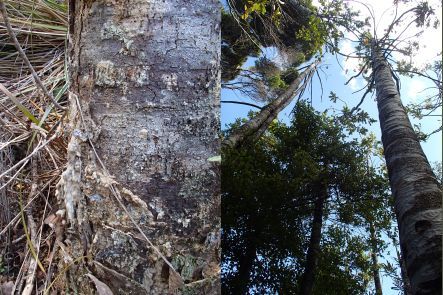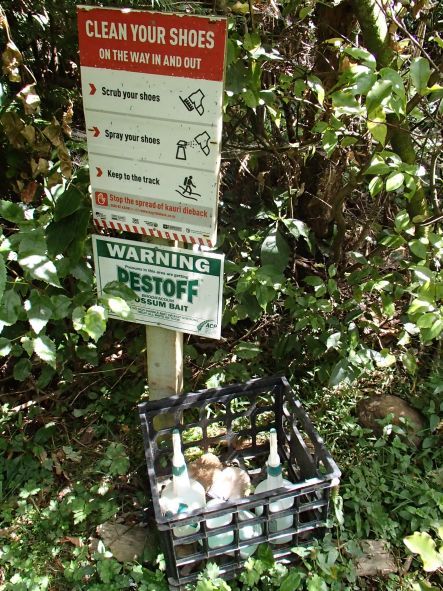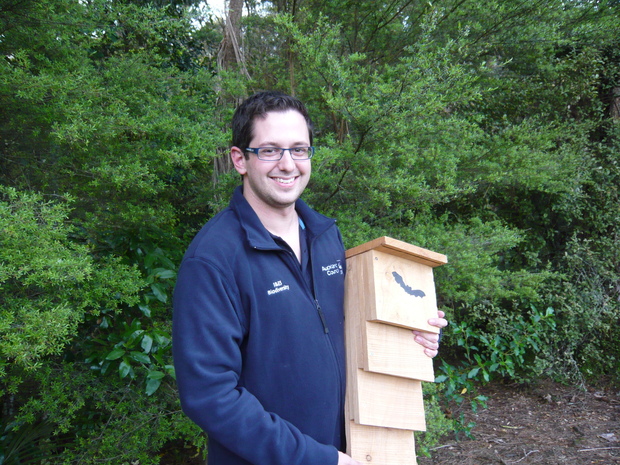Our Changing World for Thursday 16 January 2014
Welcome to Summer Science, a special edition of highlights from 2013
On This Programme
Kauri Dieback Disease
This summer science highlight is a short excerpt from a one-hour feature on kauri dieback disease - you can find the full audio here.
Five years ago a new plant disease was identified in New Zealand – Phytophthora taxon Agathis, also known as PTA, or kauri dieback disease, which infects and kills giant native kauri trees (Agathis australis). The effects of kauri dieback disease were first noticed 40 years ago in a stand of trees on Great Barrier Island, but the organism was wrongly identified as another species of Phytophthora and it wasn’t until the mid-2000s that the late Ross Beever realised that organism was actually PTA. There is no cure and no vaccination for PTA, which is found only in New Zealand and infects only kauri trees.

Oozing sap, or gumosis, at the base of the trunk (left) is a sign a kauri tree is infected with kauri dieback, as is the bare canopy of the trees to the right (images: A. Ballance)
PTA is a water-borne Chromista or water mould, belonging to a group of organisms known as Oomycota, which are relatives of fungi. Its spores infect the roots and base of kauri trees, which produce large amounts of sap in response – this gum and canopy dieback are the main diagnostic signs of an infection. Over several years large kauri trees are gradually ‘ringbarked’ by the disease and gradually die. In the last decade kauri dieback disease has become widespread in west Auckland, the Waitakere Ranges and the great kauri forests of Northland. It is still absent from the Coromandel Peninsula, the Hunua ranges and Waiheke Island.
The official kauri dieback programme began in October 2009, a year and a half after PTA was identified as a new disease. It received funding for 5 years of research and management. The kauri dieback programme is a joint agency response that involves the Ministry of Primary Industries, Department of Conservation, Auckland Council, tangata whenua, and Northland, Waikato and Bay of Plenty Regional Councils. Its main message to the public is to protect kauri by cleaning gear and staying on tracks in the forest.
Alison Ballance visits a number of places and people to find out about the disease and its impact. In the Waitakere ranges University of Auckland ecologists Bruce Burns and George Perry are establishing long-term monitoring plots to study the impact of kauri deaths on forest structure. Luitgard Schwendenmann is also beginning long-term work that will look at the impacts of kauri death on carbon storage and litter fall in forests.
Stanley Bellgard at Landcare Research carries out diagnostic work to identify the PTA – this is a slow process that involves ‘baiting’ the spores to plant material. Arborists Martin Herbert and Matthew Priestley from Treescape are often called in to fell kauri trees that have died from PTA and they explain how PTA impacts their work.
Funding for the kauri dieback programme ends in 2014, and Auckland Council is currently lobbying central government in an effort to secure further funding. In the meantime everyone involved with PTA has one clear message for the public: always clean footwear and gear with Trigene when you enter and leave kauri forests, and please stay on the track to avoid spreading the disease in soil on your boots.

Legal Highs – Student Podcast
Students from the Centre for Science Communication at the University of Otago learn about the many varied aspects of science communication, including making an audio podcast, and as part of Summer Science we are playing four of these student podcasts. This week's podcast was produced by Thalita van Aswegen, in response to lots of media coverage in July 2013 when the Psychoactive Substances Act came into force, limiting but not outlawing the sale of drugs such as synthetic cannabis.
Thalita talks with post-doctoral researcher Phil Brownjohn from the School of Physical Education, Sport and Exercise Sciences at the University of Otago about the effects of synthetic cannabis, and canvases some opinions about whether or not it should be sold.
Three Kings Islands Marine Expedition

Expedition vessel RV Braveheart, and the Princes Islands group (images: A. Ballance)
This summer science highlight is a short excerpt from a 40-minute feature - you can find the full audio here.
The Three Kings Islands lie just 55 kilometres north of Cape Reinga, but as a team of marine biologists discovered during a two-week expedition in April 2013 these storm-battered islands are a world of their own, with an underwater world that is distinctly different from the nearby mainland.

Wendy Nelson sorting seaweeds, butterfly perch and Johnson's sargassunm, and Severine Hannam sorting inverebrate samples after a dive (topside images: A. Ballance & underwater image: M. Francis)
Alison Ballance joined the Three Kings Islands Marine Expedition on board RV Braveheart, skippered by Matt Jolly, as a team of 14 experts and photographers sampled the marine algae, fish and invertebrates that manage to make these wave-washed shores their home. The discoveries included six new records of fish for the island group, an unusual stalked jellyfish and numerous types of seaweed, many of them rare and undescribed.
Expedition leader was Tom Trnski from Auckland Museum – he's Head of Natural Sciences and a fish biologist with a special interest in larval fish, and he also led the Museum’s 2011 Kermadec Islands Biodiscovery Expedition. Also from Auckland Museum was collection technician Ged Wiren and natural sciences collection manager Severine Hannam.

Half-banded perch amongst sponges and ascidians, and Malcolm Francis and Roberta D'Archino next to archway and cliffs in the Princes Islands - the white 'dusting' on top of the island is a large colony of gannets (underwater image: M. Francis & topside image: A. Ballance)
Roberta D’Archino from NIWA and Wendy Nelson from the University of Auckland and NIWA are marine algae (seaweed) experts. Malcolm Francis is a fish biologist at NIWA, and Kareen Schnabel looks after NIWA’s marine invertebrate collection. Vincent Zintzen is a researcher and Jeremy Barker is a research technician, both from Te Papa, and Libby Liggins is a PhD student at the University of Queensland.
Auckland's Urban Bats
Auckland Council biodiversity advisor Ben Paris, aka NZ Batman, with one of the bat boxes the council has installed in Swanson Reserve in the hope that they will encourage long-tailed bats to start roosting there. (image: V Meduna)
Few people will have seen New Zealand’s thumb-sized native bats, the country’s only native land mammals. In pre-human times, they darted about the forests in their millions, but today they are reduced to a few scattered groups.
There were once three species but the greater short-tailed bat was last seen in the 1960s and is now thought to be extinct. Of the two other species of bat, long-tailed bats, Chalinolobus tuberculatus, are more common than lesser short-tailed bats, Mystacina tuberculata, but they are seldom seen as they emerge from their roosts around dusk to hunt. They feed exclusively on flying insects, form complex social groups and, as research on radio-tagged bats in Fiordland's Eglinton Valley has shown, frequently switch between roosting alone and roosting with a colony.
Worldwide, there are two types of bat: megabats such as fruitbats, which navigate mainly by sight, and microbats, which locate prey using echolocation. New Zealand's bats are microbats. They emit pulses of high-frequency sound and listen for the returning echoes that bounce off objects.
Both lesser short-tailed and long-tailed bats are threatened and in danger of extinction, but long-tailed bats have been found roosting in suburban areas of Auckland. They have been observed feeding at Swanson Reserve, are roosting in the Waitakere Ranges, and the search will be on this summer at Riverhead to find the roosting site of a newly found population.
In this interview, Auckland Council biodiversity advisor Ben Paris (pictured above), perhaps better known as New Zealand Batman, takes Veronika Meduna on a bat-monitoring night walk to explain how people can help the council to detect bats and attract them to their local neighbourhood.
Contact the biodiversity team at Auckland Council on 09 301 0101 or email biodiversity@auckland council.govt.nz for information or to report bat sightings.
Next Week
We will be back next week with a new series of Our Changing World for 2014.
